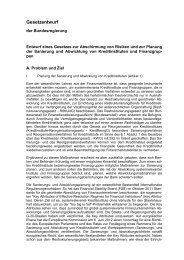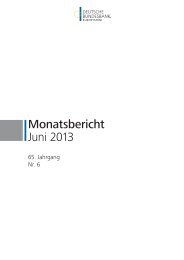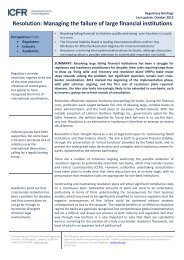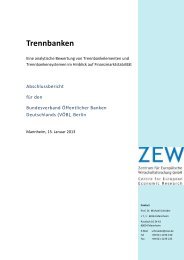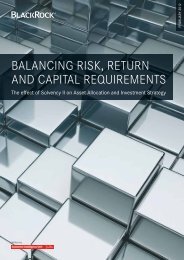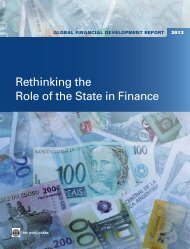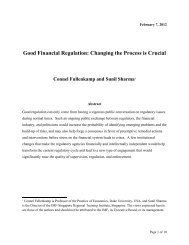3 Issuing costs of state guaranteed bonds - Financial Risk and ...
3 Issuing costs of state guaranteed bonds - Financial Risk and ...
3 Issuing costs of state guaranteed bonds - Financial Risk and ...
You also want an ePaper? Increase the reach of your titles
YUMPU automatically turns print PDFs into web optimized ePapers that Google loves.
2 Overview <strong>of</strong> <strong>state</strong> guarantee schemes<br />
2.1 Introduction<br />
2 Overview <strong>of</strong> <strong>state</strong> guarantee schemes<br />
The intensification <strong>of</strong> the financial crisis had marked impacts on the EU banking sector, particularly<br />
through 2008Q4. This incited national governments to support financial institutions through a<br />
range <strong>of</strong> rescue programmes, including <strong>state</strong> guarantees.<br />
Through this period, the appropriateness <strong>of</strong> policy responses taken at Member State level were<br />
being weighed, as were the best courses <strong>of</strong> action for further interventions. The overall conclusion<br />
was to implement a coordinated framework based on a set <strong>of</strong> EU common principles to guide<br />
national decision-making regarding interventions. 5<br />
The key motivation for using <strong>state</strong> guarantees was to enhance the soundness <strong>and</strong> stability <strong>of</strong> the<br />
banking system, <strong>and</strong>, overall, to restore confidence <strong>and</strong> the proper functioning <strong>of</strong> wholesale<br />
funding markets.<br />
However, other considerations were also taken into account in the design <strong>of</strong> <strong>state</strong> guarantees.<br />
Firstly, a distinction was made between financial institutions whose circumstances were due to<br />
general market conditions (<strong>of</strong> the nature described above) but were fundamentally sound <strong>and</strong><br />
those institutions whose pre-existing weaknesses were exposed through the financial crisis.<br />
Specifically, <strong>state</strong> guarantees were viewed as a suitable intervention for the former group <strong>of</strong> banks<br />
but not the latter.<br />
Secondly, there was also a preoccupation to ensure, to the extent possible, a level playing field<br />
between banks issuing <strong>state</strong> <strong>guaranteed</strong> <strong>bonds</strong> <strong>and</strong> other banks, <strong>and</strong> minimise any competition<br />
distortions that might arise from the granting <strong>of</strong> <strong>state</strong> guarantees.<br />
Reflecting these points, <strong>state</strong> guarantees shifted from the provision <strong>of</strong> individual guarantees <strong>and</strong><br />
moved largely towards generalised schemes. This reflected the systemic scale <strong>of</strong> the problem <strong>and</strong><br />
the need for a system-wide solution. It also took into account the potential for fragmentation <strong>of</strong><br />
wholesale funding markets.<br />
Eligibility criteria codified, among other things, the requirement that only solvent banks could take<br />
up a <strong>state</strong> guarantee.<br />
More generally, the set-up <strong>of</strong> schemes with predominantly rules-based rather than discretionary<br />
access implied that banks could evaluate whether they wished to participate in <strong>state</strong> guarantee<br />
schemes or not. It was expected that transparent <strong>and</strong> fair access would help to minimise any<br />
potential negative competition.<br />
In addition to these specific principles relating to effectiveness, competition issues <strong>and</strong> market<br />
fragmentation, the general policy approach set out conditions specifying the circumstances in<br />
which <strong>state</strong> aid would be justified. Broadly, the criteria relate to the evaluation <strong>of</strong> whether there is<br />
a 'serious disturbance' that would have an immediate impact on the entire economy <strong>of</strong> a Member<br />
5 Among the key texts highlighting this process are Ec<strong>of</strong>in Council (2008) <strong>and</strong> European Commission (2008).<br />
15



